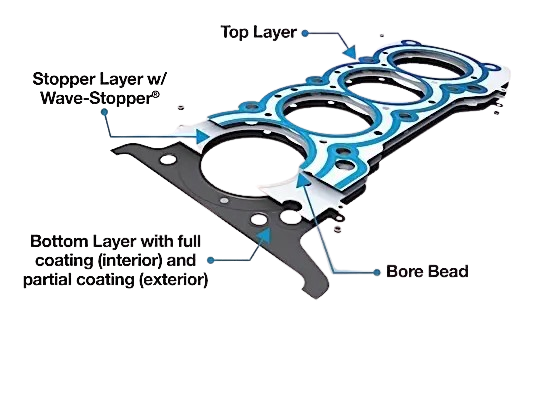 An engine is a complex assembly of various components working together to ensure smooth operation. One crucial component that plays a vital role in maintaining engine efficiency and longevity is the engine gasket. In this blog, we will explore what an engine gasket is, the different types available, and why it is essential for the proper functioning of an engine.
An engine is a complex assembly of various components working together to ensure smooth operation. One crucial component that plays a vital role in maintaining engine efficiency and longevity is the engine gasket. In this blog, we will explore what an engine gasket is, the different types available, and why it is essential for the proper functioning of an engine.
What is an Engine Gasket?
An engine gasket is a mechanical seal placed between two or more surfaces of an engine to prevent leaks of fluids such as oil, coolant, and gases. It ensures that different engine parts remain properly sealed and function efficiently under extreme conditions. Gaskets are typically made of materials like rubber, metal, composite, or multi-layered steel, depending on their purpose and the level of pressure they need to withstand.
Types of Engine Gaskets
There are several types of engine gaskets, each designed for a specific function. The most common types include:
1. Head Gasket
The head gasket sits between the engine block and the cylinder head, sealing the combustion chamber to prevent coolant and oil from mixing with combustion gases. It must withstand high temperatures and pressure, making it one of the most critical gaskets in an engine.
2. Intake Manifold Gasket
This gasket seals the intake manifold to the cylinder head, preventing air and fuel mixture leaks that could lead to inefficient combustion. It also helps regulate engine vacuum pressure, which is crucial for proper performance.
3. Exhaust Manifold Gasket
The exhaust manifold gasket seals the connection between the exhaust manifold and the cylinder head, ensuring that exhaust gases exit the engine properly. It prevents harmful gases from leaking into the engine bay, improving emissions and engine efficiency.
4. Valve Cover Gasket
This gasket seals the valve cover to the top of the engine, preventing oil leaks from the cylinder head. It is usually made of rubber or cork and must withstand heat and oil exposure over time.
5. Oil Pan Gasket
Located between the oil pan and the engine block, this gasket prevents oil from leaking out of the pan. It plays a crucial role in maintaining proper engine lubrication.
6. Water Pump Gasket
This gasket seals the water pump to the engine block, ensuring that coolant circulates properly without leaking, which helps prevent engine overheating.
7. Timing Cover Gasket
The timing cover gasket seals the timing cover to the engine, preventing oil leaks from reaching the timing chain or belt, which could lead to performance issues.
Importance of Engine Gaskets
| Importance | Description |
|---|---|
| Preventing Leaks | Gaskets create a tight seal, preventing leaks of oil, coolant, and gases. |
| Ensuring Proper Combustion | The head gasket maintains the combustion chamber’s seal for efficient fuel combustion. |
| Maintaining Temperature Control | Gaskets help regulate engine temperature by preventing coolant and oil mixing. |
| Enhancing Engine Longevity | Proper sealing protects engine components, reducing wear and tear. |
| Reducing Emissions | Ensures harmful gases do not escape, improving environmental compliance. |
Conclusion
Engine gaskets may be small, but they play a significant role in maintaining an engine’s performance and durability. Understanding their types and importance can help vehicle owners and mechanics ensure proper maintenance and timely replacements. A well-maintained gasket system leads to improved efficiency, reduced emissions, and a longer-lasting engine.


